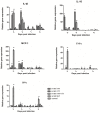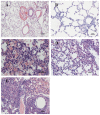Glycosylation on hemagglutinin affects the virulence and pathogenicity of pandemic H1N1/2009 influenza A virus in mice
- PMID: 23637827
- PMCID: PMC3634815
- DOI: 10.1371/journal.pone.0061397
Glycosylation on hemagglutinin affects the virulence and pathogenicity of pandemic H1N1/2009 influenza A virus in mice
Abstract
The two glycosylation sites (Asn142 and Asn177) were observed in the HA of most human seasonal influenza A/H1N1 viruses, while none in pandemic H1N1/2009 influenza A (pH1N1) viruses. We investigated the effect of the two glycosylation sites on viral virulence and pathogenicity in mice using recombinant pH1N1. The H1N1/144 and H1N1/177 mutants which gained potential glycosylation sites Asn142 and Asn177 on HA respectively were generated from A/Mexico/4486/2009(H1N1) by site-directed mutagenesis and reverse genetics, the same as the H1N1/144+177 gained both glycosylation sites Asn142 and Asn177. The biological characteristics and antigenicity of the mutants were compared with wild-type pH1N1. The virulence and pathogenicity of recombinants were also detected in mice. Our results showed that HA antigenicity and viral affinity for receptor may change with introduction of the glycosylation sites. Compared with wild-type pH1N1, the mutant H1N1/177 displayed an equivalent virus titer in chicken embryos and mice, and increased virulence and pathogenicity in mice. The H1N1/144 displayed the highest virus titer in mice lung. However, the H1N1/144+177 displayed the most serious alveolar inflammation and pathogenicity in infected mice. The introduction of the glycosylation sites Asn144 and Asn177 resulted in the enhancement on virulence and pathogenicity of pH1N1 in mice, and was also associated with the change of HA antigenicity and the viral affinity for receptor.
Conflict of interest statement
Figures







References
-
- Lin T, Wang G, Li A, Zhang Q, Wu C, et al. (2009) The hemagglutinin structure of an avian H1N1 influenza A virus. Virology 392: 73–81. - PubMed
-
- Kornfeld R, Kornfeld S (1985) Assembly of asparagine-linked oligosaccharides. Annu Rev Biochem 54: 631–664. - PubMed
-
- Hirschberg CB, Snider MD (1987) Topography of glycosylation in the rough endoplasmic reticulum and Golgiapparatus. Annu Rev Biochem 56: 63–87. - PubMed
Publication types
MeSH terms
Substances
LinkOut - more resources
Full Text Sources
Other Literature Sources

